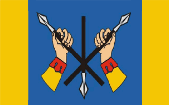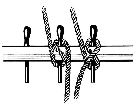- BANNER ROLL
- An 18th Century corruption, now obsolete, of the also obsolete term bannerole
(see 'bannerole').
Please note, it is suggested that this term could also apply to a roll or scroll
depicting banners.
- BANNERET
- 1) A term sometimes used to describe a miniature banner; this is often (but
not invariably) straight-sided and swallow-tailed, is designed to be displayed
vertically and usually shows emblems of both national and local significance (see
also bannerette,
emblem, general and
swallow-tail(ed)).
- 2) A medieval term, now obsolete, for a knight entitled to lead men into
battle a knight banneret whose armigerous
and whose lance pennon was square-ended, or for the group of knights so lead
a banneretus (see also
armigerous,
banderium,
lance pennon 1)
and pennoncier).
- BANNERETTE (or BANERETTE)
- 1) A small ceremonial banner decorating a set of bagpipes, a drum or a trumpet
a drum banner, pipe banner or a trumpet banner or tabard (see also
war banner).
- 2) See banner 3.
- BANNERETUS
- A medieval term, now obsolete, for a banneret (see
banneret 2)).
- BANNERHAUPT
- See bannerhead.
- BANNERHEAD
- The term - and a direct translation of the German term "bannerhaupt" used
in German language vexillology - to describe the usually (but not invariably)
white area of field that may appear at the head of a hanging flag or a banner
and usually bearing a civic or regional coat of arms (see also
banner 2),
hanging flag and
hoisted flag).


Banner of Bad Westernkotten, Germany (Klaus-Michael Schneider);
Hanging Flag of Frankfurt am Main, Germany (fotw)
- BANNERMAN
- 1) In largely Scottish usage a term, now obsolete, for one who bears a standard.
- 2) An originally 17th century term, now obsolete, for a Chinese soldier
belonging to one of the eight banners (or divisions) of the Manchu army
(see also banner 7)).
- BANNEROLE (or BANNEROL)
- The term, now obsolete, for a small flag (usually three feet - 91 cm - square) that displayed a
single quartering from a deceased persons coat of arms for use at that persons
funeral a banner roll (see also achievement of arms 2),
badge banner,
canton 3),
coat of arms,
great banner,
grumphion and
quartering).
Please note - not be confused with banderole (see
banderole).
- BAR
- See Appendix VI.
- BARBED
- A heraldic term used when describing the leaves of a rose or the metal point of an arrow
or of a spear, particularly when these are of a different tincture - but see note below and
shafted (also
garnished,
hafted,
hilted, rogacina and
tincture).



Flag of Ceskύ Krumlov, Czech Republic (fotw); Flag of Dalecarlia, Sweden (fotw);
Flag of Spytkowicem, Poland (Jarig Bakker
Please note that this term is sometimes also applied to the thorns found on the
stem of a rose.
- BARGE FLAG
- In UK usage, one of a number of varying flags (usually a banner of arms) which
are flown from the ceremonial barges of Londons livery companies (see also
boat flag 3)).
- BARRULET (BARRELET, BARRULY or BARRULLY)
- See Appendix VI.
- BARRY
- See Appendix VI.
- BASE
- 1) In heraldry a term for the lower section of a shield or banner of arms,
which heraldic use frequently suggests should occupy roughly one-third of the
total depth of that shield or flag - a Champagne (see also
banner 1),
coat of arms,
field, pointed
and shield).
- 2) In vexillology an alternative name for the bottom edge of a flag.

- BASE FLAG
- In US Air Force usage, a post flag (see also
post flag 1)).
- BATHING FLAG
- See beach flag
- BATTALION RING
- A term for a metal band sometimes placed on the staff of a military or national
colour (usually below the lower edge of the flag), and showing the battalion and
regiment to which it belonged a ring (see also
battle honour, colour 2)
and staff 2).
Please note that as far as can be determined, this
was a custom formerly in the US Army (but still in use in the US Marine Corps)
and also in some European forces. see supplemental note
- BATTLE BANNER
- A generic term for those flags having heraldic (or armorial) symbolism that were carried
into battle during the medieval period (see
battle standard,
livery colours,
lance pennon 1),
pennoncelle and
standard 3)).
- BATTLE COLOUR (or COLOR)
- In US usage, the organizational colour of a combatant Marine Corps unit or
of the Corps as a whole when carried by dismounted troops (see also
branch of service flag).
- BATTLE ENSIGN(S)
- One or more large naval ensigns flown from the yardarms of a warship prior
to commencing - and during - a surface engagement at sea (see also naval ensign
under ensign and
yardarm).
Please note that a warship raises additional large-sized
ensigns prior to an engagement at sea for added identification and in case one
or more are shot away.
- BATTLE FLAG
- 1) A flag (either official or unofficial) that is specifically intended for
use in battle either to avoid confusion with the flag of an enemy or to convey
a patriotic sentiment and used in addition to or instead of military colours
(see also colour 2),
colours 2),
Southern Cross 2))
and stainless banner.
- 2) In US naval usage, an unofficial flag, sometimes marked with stars to
recall the number of times a particular vessel has been in combat, and flown from the yardarm when entering
or leaving port, completing underway refuelling, parting company with other ships,
or similar occasions a house flag or unrep flag (see also
yardarm).
- 3) In some Central and East European usage (eg the Romanian Drapel de lupta literally meaning battle flag) -
an alternative term for a military colour but see
colour 2) (also war flag 2))

Battle Flag of the Army of Northern Virginia, CSA 1861 1865 (fotw)
Please note with regard to 2), that these flags
have no standard pattern, official existence or meaning, but are designed and
used by individual ships companies to express pride in their vessels, that their
use has become traditional in the US Navy, that US and that other naval forces
have official naval code signals to order and conduct operations such as underway
replenishment (with these unofficial flags being hoisted in addition).
- BATTLE HONOUR (or HONOR)
- A mark of distinction, usually including the name of a battle or campaign,
added to a regimental or other unit colour to show units military service. This
may take the form of an inscription within a ribbon scroll applied to the field
of the colour, or a metal band (or bands) around the staff, or a metal clip attached
to a streamer, or to the streamer itself a battle streamer (see also
battalion ring,
colour 2),
ferrule,
staff 2)
streamer 1) and
streamer retaining ring,
and compare with augmentation of honour).
Please note however, that in many navies ships show
their battle honours on a carved board or similar on ceremonial occasions, or
when the ship is open to visitors rather than on a unit flag.
- BATTLE STANDARD
- A term, now obsolete, for the Scottish heraldic standard as carried in battle,
and there are indications that it was the smallest of three sizes (see also
standard 5),
pageant standard and
great standard).
- BATTLED (or BATTELLY)
- See embattled.
- BATTLE STREAMER
- See battle honour.
- BAUCANS (or BAUCCEDILLIAN)
- A 13th Century term, now obsolete, for the plain red streamer flown from a
ships masthead (in northern European waters) to signify that no quarter would
be given, and the size according to record was 30 yards (24.45m) long by 2 yards
(1.82m) wide (see also
flag of defiance and
streamer 2)).
![[Baucens]](../images/v/vxt-d036.gif)
Please note that this flag first appears in records
of the 1290s, and is considered to have been a direct ancestor of the later flag
of defiance. Note also no quarter would be given indicates that surrender would
not be accepted and all prisoners killed.
- BAUCEANT (BAUCEANS, BAUCENT or BEUCENNUS)
- A medieval term for the black and white banner of the
Knights Templar the balzaus
(see also balcanifer).
![[Bauceant]](../images/v/vxt-d034.gif)
One interpretation of the Bauceant (CS)
- BEACH FLAG
- A flag or pennant from one of several different systems for signalling the
condition of a beach, the state of the ocean or weather at that particular point,
and/or to what degree bathing safety precautions are in place a bathing or surfing
flag, a shark alert or alarm flag, a wind, windsurf or windsurfing danger flag or
similar (see also
red flag 1) and
storm warning flag).

Some Beach Flags and Pennants, UK, The Netherlands, Portugal and France (fotw)
- BEAKED
- The heraldic term which may be used when the beak of a bird or a bird-like creature is of a different
tincture than the body (see also
appendix V, armed 2),
attired,
gorged,
jelloped,
langued,
membered and
tincture).
- BEARING
- See charge and
charged.
- BEAUFORT
- An early 18th Century alternative term, now obsolete, for bunting see
bunting 1) (also
bewper and breadth 2)).
- BECKET
- A loop at the end of the hoist line of a flag that fastens to a toggle at
the end of the halyard when hoisting a flag a running eye or eyesplice (see
also halyard,
hoistline,
running eye and toggle).
![[becket]](../images/v/vxt-d038.gif)
Becket and toggle (AB)
- BED SHEET FLAG (or BSF)
- See logo on a bed sheet.
- BEEF PENNANT
- See bullock pennant.
Please note, information suggests that
this term - a direct translation of the French "flamme de boeuf" - may have ceased after 1792,
however, this is not certain and no equivalent signal can be found in contemporary British naval
sources. Nonetheless supply vessels of the late 19th and early 20th Century which were carrying
foodstuffs to the Royal Navy are known to have flown a beef flag.
- BELAYING PIN
- An increasingly obsolete method of securing the halyard
by means of movable vertical pins (fitted into a frame or rack at the foot of the
mast) and now largely replaced by the cleat - a tack pin or jack pin
(see also cleat
and halyard).

Wikipedia
- BEND (and BEND SINISTER)
- See Appendix VI (also
abased,
ascending diagonal and
descending diagonal).
- BEND ON (or BEND ONTO)
- (v) A nautical term for securing two pieces of rope together as in attaching
the hoistline of a flag to the halyard of a flag pole or mast (see
halyard and
hoistline).
- BENDLET (and BENDLET SINISTER)
- See Appendix VI.
- BENDWISE (or BENDWISE SINISTER)
- See in bend and
in bend sinister.
- BENDY (and BENDY SINISTER)
- See Appendix VI.
- BETHEL FLAG
- The flag of the Bethel Union, a seamans missionary organization, and occasionally flown
in the 19th Century by some British and US merchant vessels to indicate that a church service
was taking place (see also church pennant and
flying angel flag).
![[Bethel flag]](../images/v/vxt-d040a.gif)
![[Bethel flag]](../images/v/vxt-d040.gif)
- BETSY ROSS FLAG
- A pattern of the starns and stripes whose canton carried thirteen five-pointed stars arranged in a
circle, which according to legend was ordered by George Washington in 1776 and sewn by Betsy Ross
of Philadelphia (see also
continental colours,
Franklin flag,
old glory,
quincunx,
stars and stripes and
star-spangled banner).
![[Betsy Ross flag]](../images/v/vxt-d502.gif)
The Betsy Ross Pattern US National Flag (fotw)
Please note that the US flag had no official star pattern until 1818,
at which time the 20-star flag (and all subsequent flags) had official patterns for military
purposes. Since 1918 (the 48-star version), the flag has had an official pattern for all purposes,
therefore, the type above is likely one of many patterns used during the period 1777-1795.
- BEWPER (OR BEWPERS)
- A 17th Century term, now obsolete, for bunting (see also
bunting 1)).
- BEZANT
- The heraldic term for a particularly (but not exclusively) gold or yellow disc see
disc (also
roundel 2) and
plates).




From left: example; Standard of the Duke of Cornwall, UK (fotw);
Flag of Harelbeke, Belgium (fotw); Flag of Geuensee, Switzerland (fotw)
Please note that in strict English heraldic usage this term should
only be employed when the charge described is gold/yellow (or) - see tinctures in
appendix III.
- BICOLOUR (BICOLOR or BI-COLOUR)
- 1) A flag of two even or uneven stripes or bands of colour (whether divided vertically, horizontally
or diagonally) and whether defaced or plainbut see note below (also
ascending diagonal 2),
descending diagonal 2),
per fess,
per bend,
per bend sinister,
per pale,
deface,
plain 2) and
stripe).
- 2) An undefaced flag with two equal (vertical or horizontal) stripes or bands
of colour a simple bicolour (see also undefaced).
![Bicolour [Poland]](../images/v/vxt-d522.gif)
National Flag of Poland (fotw)
![[bicolor flags]](../images/v/vxt-d042.gif)
From left: National flag of Haiti (fotw); National Flag of Portugal
(fotw); National Flag of Bhutan (fotw)
Please note that the division line on a bicolour may be described by
using the vexillogical terms: horizontal or vertical, by 'descending diagonal' and 'ascending diagonal';
or by the corresponding heraldic terms (party/divided): 'per fess', 'per pale', 'per bend' and
'per bend sinister'.
- BILLET
- The heraldic term for a small rectangular charge usually (but not invariably) shown upright.



From left: example; Flag of Chastre, Belgium (fotw); Flag of Kampenhout, Belgium (fotw)







![[Betsy Ross flag]](../images/v/vxt-d502.gif)




![Bicolour [Poland]](../images/v/vxt-d522.gif)
![[bicolor flags]](../images/v/vxt-d042.gif)





![[Baucens]](../images/v/vxt-d036.gif)
![[Bauceant]](../images/v/vxt-d034.gif)
![[becket]](../images/v/vxt-d038.gif)

![[Bethel flag]](../images/v/vxt-d040a.gif)
![[Bethel flag]](../images/v/vxt-d040.gif)